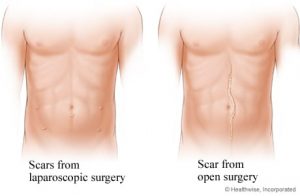How much does a laparoscopic surgery cost in Kenya?
Laparoscopy (also known as keyhole surgery – minimally invasive surgery) is a type of surgical procedure that allows a surgeon to access the inside of the abdomen (tummy) & pelvis without having to make large incisions in the skin.

Large incisions can be avoided during #laparoscopy because the surgeon uses an instrument called a laparoscope ( a small tube that has a light source and a camera, which relays images of the inside of the abdomen or pelvis to a television monitor)
The advantages of this technique over traditional open surgery include:
A shorter hospital stay and faster recovery time
Less pain and bleeding after the operation
Reduced scarring.

#Laparoscopy can be used to help diagnose a wide range of conditions that develop inside the abdomen or pelvis. It can also be used to carry out surgical procedures, such as removing a damaged or diseased organ, or removing a tissue sample for further testing (biopsy).
#Laparoscopy is most commonly used in:
Gynaecology – the study and treatment of conditions affecting the female reproductive system.
Gastroenterology – the study and treatment of conditions affecting the digestive system.
#Laparoscopy is carried out under general anaesthetic, so you won’t feel any pain during the procedure.
During laparoscopy, the surgeon makes one or more small incisions in the abdomen. These allow the surgeon to insert the laparoscope, small surgical tools, & a tube used to pump gas into the abdomen. This makes it easier for the surgeon to look around and operate.
After the procedure, the gas is let out of your abdomen, the incisions are closed using stitches & a dressing is applied.
#Laparoscopy for diagnosing conditions:
It’s often possible to diagnose a condition using non-invasive methods, such as an ultrasound scan, CT/MRI scan. Sometimes, however, the only way to confirm a diagnosis is to directly study the affected part of the body using a laparoscope.
Laparoscopic surgery can be used to treat a number of different conditions, including:
Removing an inflamed appendix – Removing the gallbladder – Removing a section of the intestine (in cancers) – Repairing hernias – Repairing burst or bleeding stomach ulcers –
performing weight loss surgery – Removing some or all of an organ affected by cancer – such as the ovaries, prostate, liver, colon, kidney or bladder – treating ectopic pregnancy – Removing fibroids – Removing the womb (hysterectomy).
How much does a laparoscopic surgery cost in Kenya?
Laparoscopic surgery is quite expensive in Kenya and even globally. The cost of laparoscopy surgery in Kenya is around Ksh 1.5 million Kenya shillings. In Nairobi and Mombasa, laparascopic surgery is around Ksh 2 million Kenyan shillings. Compared to open surgery, laparascopic surgery is more expensive.
Culled by www.nimedhealth.com.ng from Coptic Hospital
























